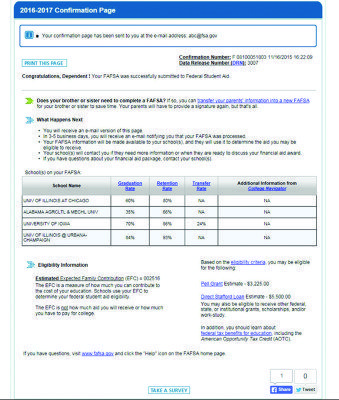 Generally, the first step in applying for financial aid is completing the Free Application for Federal Student Aid (FAFSA). The schools you listed on the FAFSA (www.fafsa.ed.gov) will take that information and use it to calculate the financial aid you’re eligible for. Your financial aid awards may vary from school to school based on a number of factors including: your Expected Family Contribution (EFC), the number of credits you will take each term, your cost of attendance (COA) at each school, your eligibility for state and institutional aid at each school, and your year in school. Keep in mind that many schools have a priority deadline, so the sooner you apply each year, the better.
Generally, the first step in applying for financial aid is completing the Free Application for Federal Student Aid (FAFSA). The schools you listed on the FAFSA (www.fafsa.ed.gov) will take that information and use it to calculate the financial aid you’re eligible for. Your financial aid awards may vary from school to school based on a number of factors including: your Expected Family Contribution (EFC), the number of credits you will take each term, your cost of attendance (COA) at each school, your eligibility for state and institutional aid at each school, and your year in school. Keep in mind that many schools have a priority deadline, so the sooner you apply each year, the better.
Here are 5 things that will help you better understand how financial aid is awarded:
1 States, colleges and outside agencies may require additional applications.
Beyond federal financial aid, which is determined by completing the FAFSA, some states and colleges may require additional applications to determine your eligibility for state or institutional (college) financial aid. Check with the financial aid office at each college you are applying to and ask whether they require additional applications. (Also ask about deadlines!) These applications may include consideration for state or institutional grants, scholarships, work-study and loans.
Tip: Don’t forget about outside scholarships, which may require separate applications as well.
2 The FAFSA confirmation page is not your financial aid award.
After you complete the FAFSA online, you’ll receive a confirmation page.
This page includes a lot of helpful information, so you should read it carefully. However, there is often confusion surrounding two sections on this page:
• Expected Family Contribution (EFC) (bottom left): The information you report on your FAFSA is used to calculate your EFC. It’s very important to note that the EFC, in most cases, is not the amount of money your family will have to pay for college. Therefore, if your EFC is zero, that does not mean you will have zero out of pocket expenses. Instead, the EFC is an index number used by financial aid offices to calculate how much financial aid you would receive if you were to attend their school.
Contrary to popular belief, the EFC formula considers more than just income. Factors such as dependency status, family size and the number of children in your family who are attending college are just a few of the additional factors considered.
• Federal Aid Estimates (bottom right): The FAFSA confirmation page provides federal aid estimates based on the information you provided on your FAFSA. It’s important to know that these figures are truly estimates and assume the information you provided on the FAFSA is correct. To calculate the actual amount of aid you’re eligible for, your school will take into account other factors, such as the cost to attend the school. Additionally, these estimates only take into account federal aid and not outside scholarships or state and institutional financial assistance you may also be eligible for.
Tip: Each school you are accepted to and include on your FAFSA will send you a financial aid award. Until you receive this award letter/notification from a school, it may be difficult to know exactly how much aid you might be eligible to receive from that specific school. In the interim, you can use the Net Price Calculator (www.collegecost.ed.gov/netpricecenter.aspx) to help get a general idea of what aid you are likely to receive from a specific school.
3 How financial aid is calculated: COA – EFC = Financial Need.
Cost of attendance (COA) minus Expected Family Contribution (EFC) equals financial need. This formula is the starting point to calculating your financial aid package. COA is an estimate of what it will cost you to go to school, in most cases for two semesters or three quarters. COA is more than just tuition and fees; it includes room and board, books and supplies, transportation and miscellaneous personal expenses.
The financial aid office at your school will determine how much financial aid you are eligible to receive.
Schools will first award need-based aid, such as grants and subsidized loans, before awarding non-need-based aid, such as unsubsidized loans. The total amount of aid you will be awarded in almost all cases cannot exceed your COA.
Tip: Oftentimes a student’s financial need is higher than the need-based awards a student is eligible to receive. Therefore, just because a student has high need does not mean they will only be awarded need-based aid. Other factors must be taken into account, such as cost of attendance.
4 Financial aid award letters are school specific.
There is not a standard award letter, so while some letters you receive may look similar, others may look completely different. Certain schools may send you a paper letter or award packet, while others may provide the information electronically. Many schools may also send you a Shopping Sheet (www.collegecost.ed.gov/shopping_sheet.pdf), which is a standardized format letter that provides personalized information on financial aid and net costs, as well as general information on institutional outcomes, such as graduation rates and loan default rates.
Because these letters/notifications may look different, you should be careful when comparing them. You may be awarded the same amount of federal aid from school to school, but it would not be uncommon to see varying award packages depending on the schools you are applying to.
Tip: Keywords to look for are: grant or scholarship (both are types of financial aid that don’t have to be repaid), work-study (earned through working), and loan (needs to be repaid).
5 FAFSA information doesn’t always accurately reflect a family’s financial situation.
We understand that the FAFSA does not always accurately reflect your family’s current financial situation and that your situation can change. While schools are not required to consider special circumstances, many schools do. There are a number of factors schools may consider, such as loss of a job or a reduction in income as compared to what was reported on the FAFSA. It’s important to know that even if your current situation has changed considerably, it may still have little or no impact on your overall financial aid award. Discuss your circumstances with a financial aid counselor/advisor at the school before collecting and sending in all the required documents.
Tip: Check with the financial aid office to find out if they consider special circumstances and if so, how you go about submitting a petition for reconsideration of your financial aid eligibility.


















